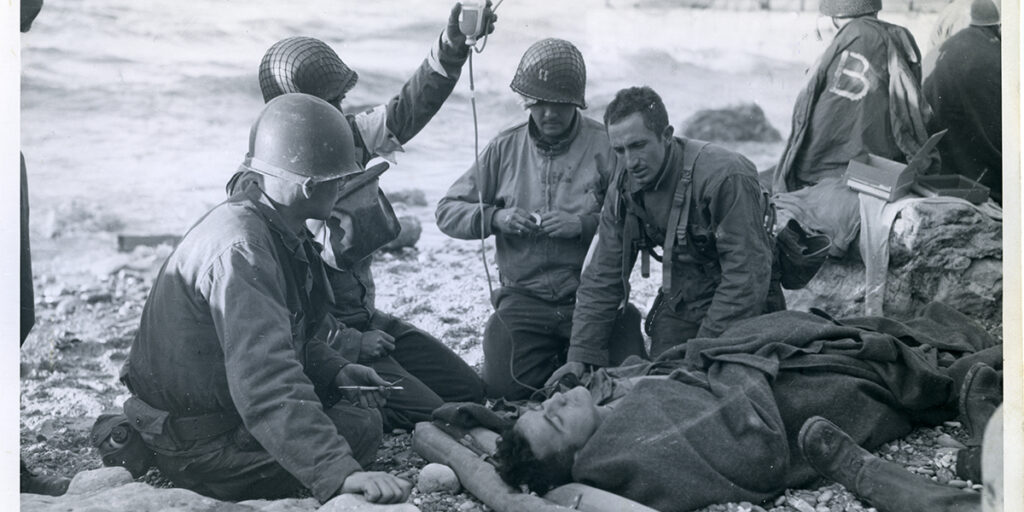Table of Contents
On June 6, 1944, Allied forces faced the daunting task of invading Fortress Europe across the beaches of Normandy. In their preparation for battle, the medical corps of the United States Army drilled and trained to save lives on this vitally important battlefield. In doing so, they followed in the footsteps of their Civil War predecessors and the lessons first learned by Major Jonathan Letterman on the battlefields of Maryland in September 1862.

Major Letterman’s innovative plan for medical organization and evacuation during the Civil War faced its first test on America’s bloodiest day at Antietam on September 17, 1862. Faced with the task of caring for more than 10,000 wounded soldiers, Letterman’s surgeons and stewards jumped into action utilizing a new system that emphasized several key components.
Letterman created an organized ambulance corps within the Army of the Potomac mere weeks before the fight at Antietam. Shortly thereafter, ambulance drivers and stretcher-bearers began practicing the removal of wounded soldiers from the battlefield to field hospitals in the rear. Their training under Letterman’s newly implemented system emphasized speed and efficiency.

On the battlefield, assistant surgeons were to establish aid stations in close proximity to the battlefield in order to provide life-saving first aid and organize the evacuation of wounded soldiers to the rear for further treatment or surgery. Medical personnel evaluated each patient and ensured that those with severe, treatable wounds received the first attention of surgeons further in the rear. Today, we call this triage.
Major Letterman mandated that field hospitals be organized by division, centrally located near the battlefield, and staffed by skilled surgeons and medical personnel. Instead of hospitals scattered across the battlefield, whose location was dictated by junior medical officers, Letterman and his team at Army headquarters placed hospitals in locations designed to expedite the flow of wounded and provide medical care more efficiently.

All the while, far in the rear, Letterman’s team selected hospital sites for wounded and sick soldiers close to a major railhead for speedy evacuation to general hospitals established in larger cities. These evacuation hospitals allowed military medical personnel to oversee medical care from the moment of wounding through long term rehabilitation.
On the battlefield at Antietam on September 17, 1862, Major Letterman put his plan into action. The results spoke for themselves: more than 10,000 wounded Union and Confederate soldiers were evacuated from the blood-soaked battlefield within 24 hours of the end of hostilities, a stark contrast to earlier Civil War battles when wounded soldiers languished on the battlefield for days after the fight. Letterman’s system worked, effectively removing the wounded from the battlefield in a timely fashion. The training regimen for ambulance drivers and stretcher-bearers proved to be effective.
There were hiccups – Letterman spent his entire career as Medical Director of the Army of the Potomac fine-tuning his plan – but the system proved to be an innovative step forward in the United States Army’s ability to save lives on the battlefield.
More than 80 years later, the United States Army prepared for one of its biggest and bloodiest days since the American Civil War. Among the many plans being laid out in order to successfully land troops along the heavily defended coast of France, military medical officials planned for their role in D-Day.
“For in the midst of all this preparation, and this training for destruction, there went on an opposite kind of preparation. Preparation for the business of saving life, preserving limb and tissue, of easing pain.”
– “Medical Service in the Invasion of Normandy”

In the following War Department Film Bulletin, Medical Service in the Invasion of Normandy, the U.S. Army lays out how it planned and executed the medical treatment and evacuation of Allied soldiers in the Normandy theater in June-August 1944, where more than 124,000 Americans became casualties.
The thorough, exhaustive planning that went into saving lives during this pivotal moment in the Second World War hearkens back to the organizational efforts of Major Jonathan Letterman during the darkest days of the Civil War.
The system he created and improved through that conflict’s bloodiest engagements – Antietam, Fredericksburg, Chancellorsville, Gettysburg – provided an effective starting place for military medical professionals in future conflicts. We are still learning valuable lessons in military medical organization from Major Letterman today.
About the Author
Jake Wynn is the Director of Interpretation at the National Museum of Civil War Medicine. He also writes independently at the Wynning History blog.
Want to learn more about Major Jonathan Letterman?
Find primary sources relating to Major Letterman’s service during the Civil War.
Click here to read more about Letterman and his work during the Civil War.
The National Museum of Civil War Medicine also honors innovation in modern military medicine – the Major Jonathan Letterman Medical Excellence Award.



Leave a Reply
You must be logged in to post a comment.